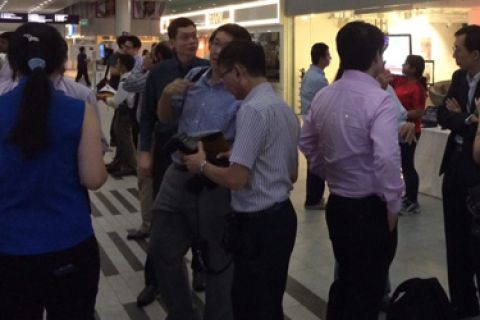
Assistant Professor Nafis Hanif studies Asian crime businesses and shows that they are driven by rational economic principles.

Photo Credit: Cyril Ng
SMU Office of Research (5 June 2014) – Mention criminal gangs and the images that come to mind are of cigar-smoking Italian mafia or heavily tattooed Japanese Yakuza. Based on popular portrayals in mainstream media, many people might assume that these powerful but shadowy organisations are ethnically homogenous, and governed by violence or fear in an irrational fashion. Assistant Professor Nafis Hanif, from the Singapore Management University’s (SMU) School of Social Sciences, challenges these stereotypes in her research.
“Different criminal businesses, from media piracy to human and drug trafficking, can all be understood as enterprises. I analyse criminal group structures, the supply chain management of illicit commodities, and the interaction between unlawful market players and illegal market dynamics, to extract, wherever possible or relevant, the entrepreneurial judgment underlying them,” she says.
It’s just business
Her finding that business principles (such as profit maximisation) motivate organised crime may come as a surprise to those who have assumed that the crime business is primarily a cultural phenomenon.
“Some researchers have observed ethnic homogeneity among gang members, or that criminal groups of different ethnicities are always at war with each other, leading them to conclude that organised crime is a racial phenomenon. However, my research shows that even the recruitment of criminal group members from a particular ethnic group is driven by an underlying economic rationale,” Professor Hanif explains.
“In this sense, a criminal group that emphasises ethnic homogeneity among its members for me is no different from a family-based or clan-based business. This does not mean that I do not see the relevance of a cultural argument in my research, but I see culture as a subset of my economic explanation.”
Professor Hanif’s conclusions are based on extensive field studies using qualitative methods and participant observation. For a media piracy project involving counterfeit DVD sellers in Malaysia, Professor Hanif lived in Kuala Lumpur for four years, spending time with distribution syndicates at shopping malls all over Malaysia, talking to the bosses and slowly gaining their trust.
“It’s not enough to just interview them and go away; it’s really about participant observation, hanging around them over many months. The additional benefit is that I also gain access to the consumers of the illegal DVDs, getting to interview them and understand their motivations,” she says.
In recognition of her contributions to the dangerous field of criminology, Professor Hanif was awarded the National Council of Women of New South Wales Australia Day Awards in 2011, sponsored by Gilbert + Tobin Lawyers, a law firm based in Sydney, Australia.
Following the laws of demand and supply
From her interactions with the illegal DVD syndicate in Kuala Lumpur, she found that the industry obeyed the laws of demand and supply, just like any legitimate business.
“The methods of the business may be different because they have to use corruption and there are no contracts in their agreements, but it is still a business. The people involved are making money, to supply something that consumers want. If no one wants it, why would anyone bother supplying it?” she remarks.
In fact, pirated DVDs are not only able to compete on price, but also on quality. By targeting members of the film censorship board, the syndicate was even able to obtain uncut versions of the latest movies, positively differentiating their product from the legal versions. Professor Hanif also notes that the normalisation of demand for pirated goods means that the syndicate enjoys easy access to customers, no longer hawking their wares in the back alleys but openly setting up stores in shopping malls.
Understanding the syndicates’ dependence on demand should influence our choices as consumers, she says.
“Crime businesses emerge and become sustainable because of consumer demand. Therefore, controlling crime businesses requires concerted efforts – to handicap the logistical organisation of the unlawful suppliers on the one hand, and to educate consumers on the consequences of their actions on the other. When people buy a pirated DVD or hire an illegal maid, they think of it as an isolated incident that won’t make a big difference. But individual decisions do matter.”
Rational decision making in criminal businesses
One other interesting finding to come out of her research is that the crime business is not as violent as many might assume it to be, and that leadership decisions are driven by rational processes rather than sheer charisma.
“I’m not saying that it’s not violent, but I’m saying that the violence I witnessed was very calculated. When people try to cheat them or break a contract, violence is not the first recourse. The crime boss told me that violence is force pretending to be power, and it actually harms the business. Because corruption is involved, you actually don’t want to attract attention to the business and risk making the various stakeholders visible. Violence is only used when absolutely necessary; other than that, normal social control methods are used,” Professor Hanif explains.
Not only is violence disfavoured as a means of conflict resolution, it is also not the basis of employment and promotion in crime businesses.
“I compared two syndicates that I studied in Malaysia with two Chinese secret societies in Singapore by looking at how they decided which members to promote. The ones known to be extremely violent would never be promoted; they would always remain just as fighters. All the crime bosses told me that the constant fighting we see on TV is not good for their business; the group that is always fighting will never make money, and the frightened consumers will never come to you,” she says.
Furthermore, Professor Hanif argues that the organisation of the syndicate is influenced by marketing considerations – to maximise consumer demand, and ensure the profitability and sustainability of the business. When it comes to deciding who the syndicate chooses to bribe and why, she finds that the underlying logic is highly rational.
“For example, one group that they try to corrupt is shopping mall directors. The reason is to ensure accessibility to consumers and business stability. In this way, customers can always find them in the mall between 8 am and 8 pm.”
Although she has already published some of her findings with Professor Mark Findlay from the SMU School of Law, Professor Hanif hopes to take her work further through collaborations, especially with colleagues from the business school.
“The two articles I am currently writing on criminal entrepreneurial judgment and rational authority among criminal entrepreneurs are particularly relevant because they draw on concepts and theories taught in the business school. I look forward to collaborating with colleagues who may be interested in criminal business supply chain organisation, illicit entrepreneurial culture, and marketing strategies,” she says.
See More News
Want to see more of SMU Research?
Sign up for Research@SMU e-newslettter to know more about our research and research-related events!
If you would like to remove yourself from all our mailing list, please visit https://eservices.smu.edu.sg/internet/DNC/Default.aspx

